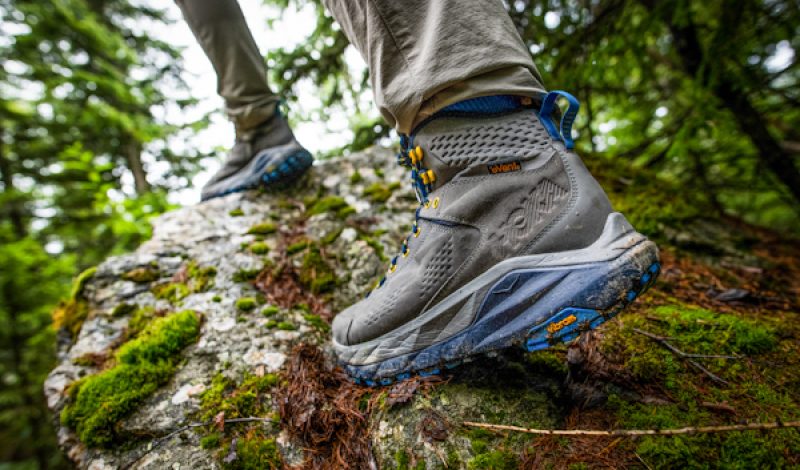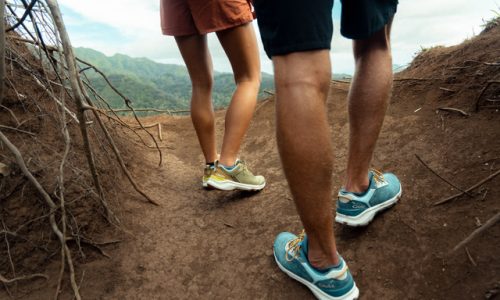Hoka One One’s new maximalist hiking boots may be grabbing a lot of attention for their uniqueness, but I noticed a real comfort improvement over traditional boots after a few outings. I wanted to dig in to the tech on these new shoes to understand what was going on.
The first thing to understand is the Hoka Sky Series boots are really light—like trail-running-shoe light. That makes them instantly feel more energetic on trail. And yet they are somehow still way thicker underfoot than anything else out there.

The thickness has an obvious comfort advantage – the molded foam is soft and well-cushioned underfoot. But the sense of comfort also comes from the protection offered by that sizable midsole. Pounding over sharp rocks and roots in most flexy, lightweight boots can leave you with bruises and pressure sores on the bottom of their feet. At the very least, your feet become fatigued.
Most boot companies address this by introducing heavier protective elements, like plastic midfoot shanks and denser midsoles. But Hoka trackles it by sticking with featherweight foam and just increasing the thickness of the midsoles. Rock bruising is completely eliminated because rocks simply can’t poke through that much foam.

How thick? The backpacking-minded Sky Kaha has 33mm of foam under the heel, with 27mm in the forefoot. That’s as much as twice the midsole thickness of some other hiking boots designed for multiday hikes. The scrambling-centered Sky Arkali has 29mm of padding under the heel and 24mm in the forefoot. The flashpacking Sky Toa features the thinnest sole with a sole thickness of 26mm at the heel and 22mm under the forefoot for an offset drop of 4mm. That’s still far thicker than most trail running shoes and hiking boots on the market today.
“Midsole volume of up to 50 percent more than standard footwear is designed to offer shock absorption, comfort, and support, and ultimately to make running and hiking easier for everyone, from an ultrarunner or serious backpacker to someone who is just starting on their hiking or fitness journey,” says Gretchen Weimer, the brand’s Global VP of Product.
Sheer size not all that’s going on in these hiking shoes and boots, though.
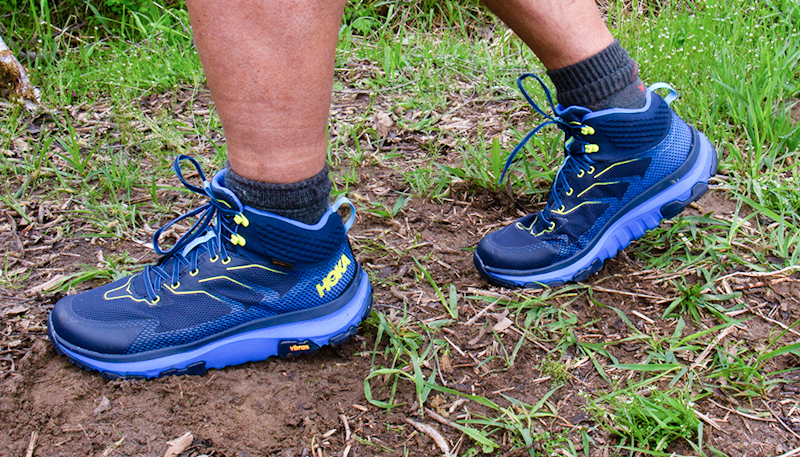
The Foam
The combination of come-to-daddy comfort and an extra thick midsole can only be accomplished by using really light midsole materials. You’ll only get a lightweight boot this thick if you use airy EVA foam (not denser material like polyurethane).
Hoka uses foam in a couple forms. Standard EVA (ethylene-vinyl acetate) foam is the softest and can provide a pillow-like feel. EVA is the classic closed-cell foam that can be molded and shaped through heating to conform to any design specs. Because some hikers prefer a more responsive ride, Hoka also employs a springier, rubberized EVA for a more energetic feel in certain parts of the shoe. Various densities of these foams can be used throughout a midsole to create more responsive and more cushioned zones—often a sign of more advanced shoe manufacturing. The new hiking collection combines both in dual- and triple-density midsoles.
Sky Kaha

The Sky Kaha backpacking boot sports a multilayered midsole. The design starts with an EVA foam top layer around the foot. Hoka uses this high-density foam at the top of the midsole to cradle the foot and provide a ‘bucket-seat’ for the foot (discussed in further detail below).
Under the EVA is a layer of lower density foam. This propriety compound is a rubberized EVA foam that is softer and springier than standard EVA, providing unmatched cushioning underfoot. Yet the foam is just dense enough that it doesn’t dampen responsiveness. The rubberized EVA compresses for comfort but springs back almost instantly.
Couple that quick recovery of the foam with the steep 6mm sole offset – the drop in thickness from heel to toe – as well as the meta-rocker of the outsole, and the Kaha provides a bit of a mechanical assist during normal strides.
Sky Arkali
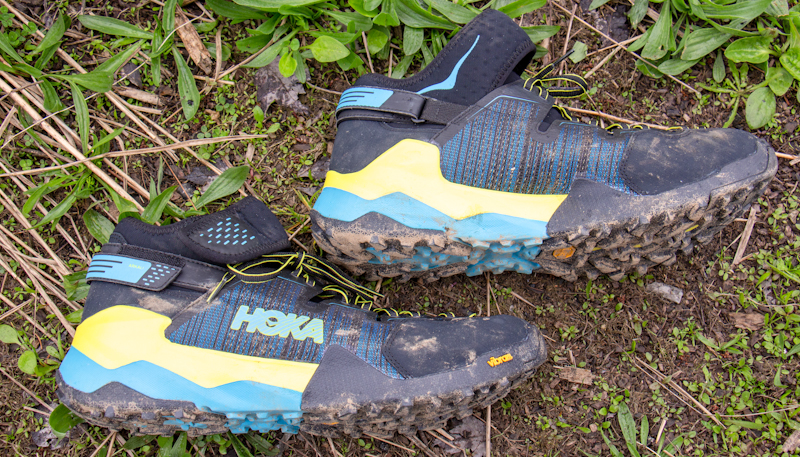 Like the Sky Kaha, the Sky Arkali sports a multilayered maximal midsole, but one designed for more technical terrain and aggressive use. The Arkali employ’s Hoka’s ProFly midsole – a dual-density EVA foam with a softer, more forgiving heel section for comfort and cushion while scrambling rocky routes. This cushion section tapers into a denser, more responsive foam in the forefoot and toe box. This gives a firmer grip when scrambling up steep rock, while also improving power during toe-off in normal hiking strides.
Like the Sky Kaha, the Sky Arkali sports a multilayered maximal midsole, but one designed for more technical terrain and aggressive use. The Arkali employ’s Hoka’s ProFly midsole – a dual-density EVA foam with a softer, more forgiving heel section for comfort and cushion while scrambling rocky routes. This cushion section tapers into a denser, more responsive foam in the forefoot and toe box. This gives a firmer grip when scrambling up steep rock, while also improving power during toe-off in normal hiking strides.
The performance of the ProFly midsole is enhanced by the use of independently adjustable heel and ankle straps. These straps give hikers the ability to fine-tune the fit of the Arkali for ultimate comfort and control.
Sky Toa
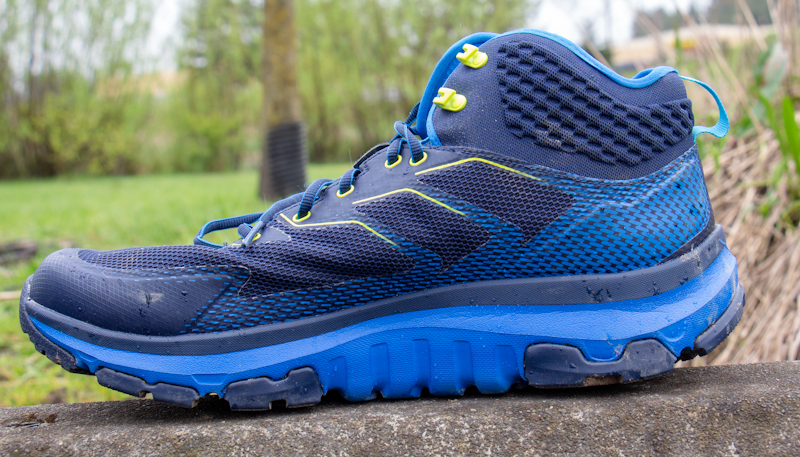
The Sky Toa’s midsole draws from the designs of both the Kaha and Arkali, with a dual-density EVA layer sitting above a cushioning core. But instead of the ProFly core, the Toa sports a ShockPad section of softer foam under the heel for shock absorption, with Hoka’s propriety rubberized EVA throughout the rest of the midsole.
Built for fast-and-light use, the Toa’s slightly thinner midsole sports a more aggressive rocker to provide more ‘assist’ in the natural stride of a faster pace.
Rockered Outsoles
The other notable tech feature on all of these models is the moderately rockered midsole. The midsoles are each curved from heel to toe, which creates a smooth rolling sensation as you walk. Hoka call’s it “Meta-Rocker” technology.

Rockered outsoles are not new in footwear—companies have been experimenting with them in various types of shoes for years—but Hoka advanced the design in its running shoes. The rolling outsole and thick midsole geometry complement each other. The rolling midsole lessens the feeling that you’re wearing a massive midsole underfoot. The slightly thinner midsole in the toes makes push-off more responsive than it would be with a thicker midsole, and the slightly thinner heel helps to roll the foot into its stride.
The Bucket Seat

The midsole is supported by the Active Footframe element. This framework cradles the foot, cupping the heel and forefoot deeply into the midsole rather than holding them atop the cushioning, as is standard in many other brands. By nestling the foot down into the midsole itself, the Hoka Sky Series boots are more reactive to foot movement and strides. This framework also helps provide inherent stability on varied terrain but helping the hiker maintain solid contact with the trail even when uneven or unstable. It’s often pointed out the idea is similar to the bucket seat on a race car, which cradles and supports the driver on turns.
Outsoles
Below the midsoles in each of the boot models, Hoka employs a Vibram Megagrip outsole, with multidirectional lugs. These 5mm lugs provide a solid bite whether striding forward, angling sideways onto a rocky slab, or descending down a steep couloir. The multidirectional lugs also help provide grip throughout the natural rolling motion generated by the Meta-Rocker design of the soles.


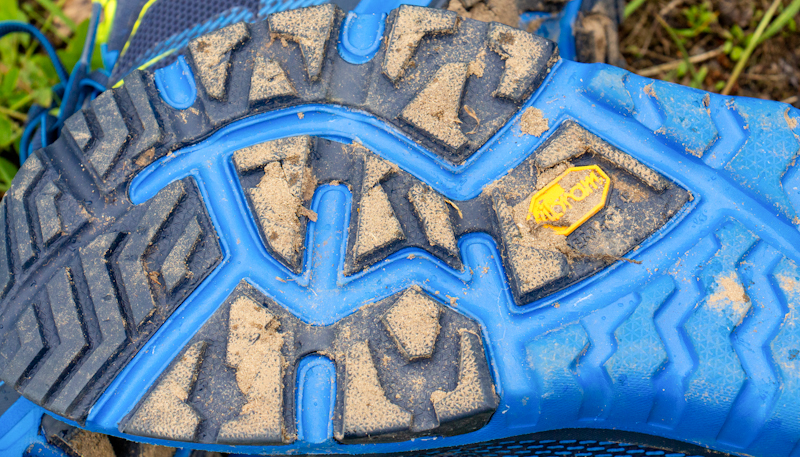
Uppers
In building this new boot series, Hoka tailored the uppers to the specific needs of each boot’s targeted use.

For multi-day backpacking, the Sky Kaha sports a full-grain leather upper for durability, support, and stability. The upper is backed with an eVent bootie for waterproofness and breathability. A well-padded tongue and traditional lace loops – with quick-release lace hooks on the last two rows – complete the upper. This traditional upper design works well with the modern midsole underfoot for long treks in the wilderness.

For the fast and light hikers, the Sky Toa and Sky Kaha, Hoka opted for greater breathability and durability in the upper. The use of different synthetic fabrics in various areas – mesh forefoot panels, dense nylon panels around the heel and toe, and expanded foam in the ankle cuffs – add up to a good combination of comfort, performance, and durability in a lightweight package. The Toa’s upper also features an eVent waterproof-breathable bootie and a traditional lacing system.

Since the Arkalis are designed for scrambling, Hoka designed the uppers to be both incredibly supportive and highly abrasion-resistant. The Arkali uppers feature a synthetic upper featuring Hoka’s proprietary Matryx material. The Matryx fabric employs high-tensile fiber strands woven into the synthetic fabric – this makes the material highly abrasion-resistant while keeping it lightweight and breathable.
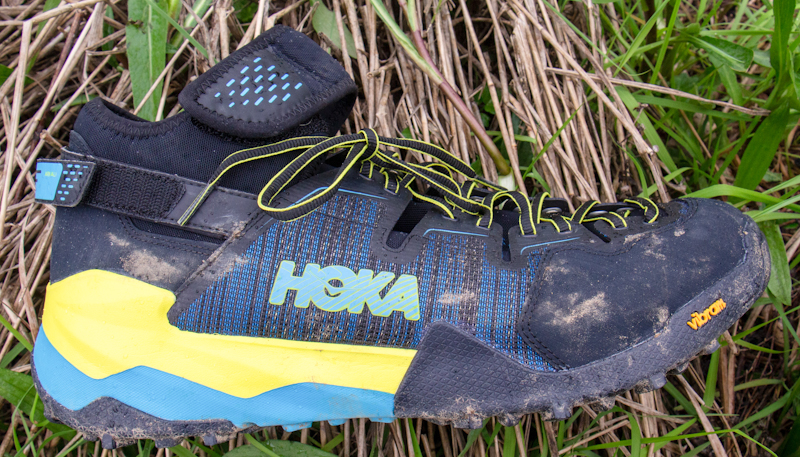
For added durability, the tough rubber toe cap extends around the toe box and back to the midfoot to reduce wear and tear when edging up steep rocks. A minimally padded tongue under a straight lace system keeps the boot locked in snuggly around the forefoot. A pair of independently adjustable straps provide a near-custom fit on the heel and ankle, ensuring the foot is locked securing into the boot’s ‘bucket seat’ atop that performance midsole.
The Complete Package
My sense is Hoka’s Sky Series boots will have broad appeal, even if the novel approach to on-trail comfort raises eyebrows among some traditionalists. It’s an approach that borrows the lessons of maximalist trail running and applies them to similar but slightly different performance goals unique to hiking. If a hiking boot can provide both underfoot comfort and protection but still stay light on the scale, that’s a big win.








